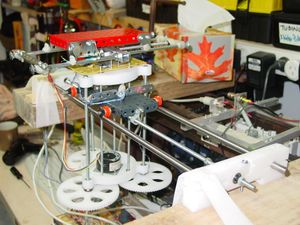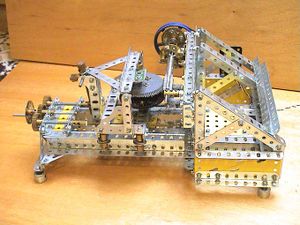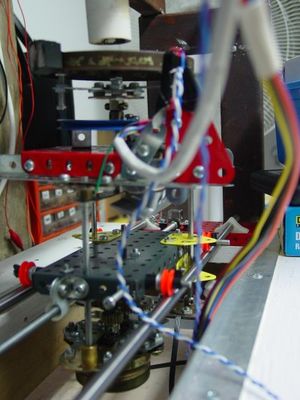PrototypePrinter
The prototype printer is constructed largely from Meccano and Polymorph. Test articles have been made on the Stratasys FDM printer that show Meccano components can be readily replicated, but for the moment there is no pressing need to use anything other than Meccano.
The device is constructed on a sturdy wooden base, which holds the mechanism clear of the ground and prevents vibrations during use. A carriage moves left-right along a 500mm length of M5 studding, powered by a stepper motor. The carriage carries a 150mm diameter turntable, which is raised and lowered by another stepper motor via a 3:1 reduction gearing and threaded rod.
The turntable is rotated by another stepper motor via a 57:1 worm gear. An index to its rotation is provided by a simple magnetic reed switch, as found in burglar alarms. The turntable has 3 adjustment screws to level it, and 3 more to level the rotating gear.
- Meccano carriage showing turntable and vertical stepper motor:
A sturdy welded metal frame constructed from 25mmx50mm steel box section with top rails 100mm apart provides a gantry for suspending extrusion heads from. Currently, a simple EVA "hot-melt glue" extruder driven by a DVD tray motor is used to provide extruded plastic, though this will be replaced with a Polymorph head. The image above shows a white plastic tube over the turntable, used to hold a marker pen in callibration tests.
Many heads may be placed on the gantry, and provided that each is lined up with the centre of the turntable the mechanism can position any point on the turntable underneath any head on the gantry.
The design is particularly suitable for the construction of rotationally symetrical parts such as gears, and has secondary uses such as winding coils.
Turntable Height Adjustment
The current prototype has a 7.5 degree/step stepper motor which drives a piece of M4 studding held in a captive bolt in the carriage body. As the studding rotates, the turntable assembly goes up or down. Stability is currently provided by 3 vertically sliding rods, and this is rudimentary at best.
To provide stability, 3 x M5 lengths of studding will be used, each one being rotated in the same direction. To ensure the stepper motor has enough strength to overcome frictional forces and any potential loads, a ratio of 5:1 will be used.
Belt drive has been suggested, but currently there is no method of belt manufacture and suitable drive belts are hard to come by. As great precision is not needed, rather chunky FDM'd gears will suffice - and will be able to be replicated in the future. With a central 16-tooth gear of a size chosen to provide clearance for 3 outer gears (22.6mm diameter), this gives outer gears with 79 teeth and an outer diameter of 104mm. This configuration should provide clearance over the existing guide rails. Use of a hexagonal recess allows M5 nuts to be used to secure the gears to the studding, keeping the configuration shown below:
The central gear will be held on the shaft of the stepper motor using a 4mm external diameter PVC plastic sleeve by friction fit. This has shown to be effective with the 3:1 gearing using finer Meccano teeth, and so should have no problems with the stresses or alignment on the larger gears.
The gears were created using ArtOfIllusion's "cog" script, with teeth 3mm high, a pitch of 3.85mm and a 0.12 slope. The cog vertices were then smoothed to 0.5 using the AoI edit tool before extruding etc.
-- Main.VikOlliver - 05 Nov 2005
For more details, see VerticalPlatform and Screw-drivenLinearAxis and Construction of Rapid-Prototyping Testbeds Using Meccano. This is Vik's report on his RP material deposition system made from a glue gun and Meccano.


